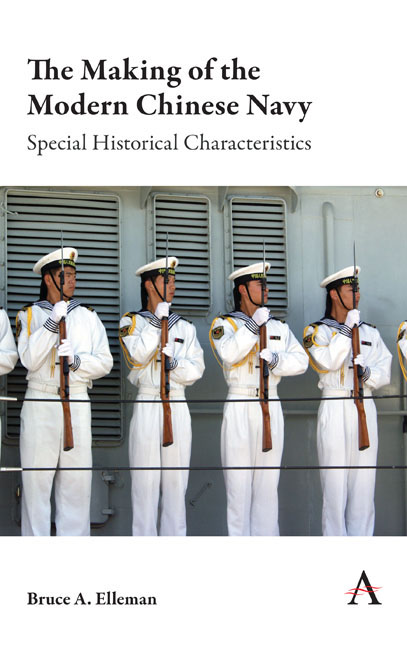Book contents
- Frontmatter
- Contents
- Introduction: The Special Characteristics of China's Maritime History
- 1 Battle of Bạch Đăng River (938)
- 2 Battle of Yaishan (1279)
- 3 Battle of Lake Poyang (1363)
- 4 Ming–Kotte War in Southeast Asia (1410–11)
- 5 Ming Loyalists Flee to Taiwan (1661–83)
- 6 Battle of Chuanbi (1839)
- 7 Sino-French War (1884–85)
- 8 Qing Beiyang Fleet's Defeat in the Battle of the Yellow Sea (1894)
- 9 Chinese Decision to Sink The Nationalist Navy as Blockships (1937)
- 10 Chongqing Mutiny Allowing the PLA to Cross the Yangzi River (1949)
- 11 The Taiwan Strait Crises (1954–55 and 1958)
- 12 China's Decision to Take the Paracel Islands from South Vietnam (1974)
- 13 Missile Blockade: The Taiwan Strait Crisis (1995–96)
- 14 The EP-3 Standoff and Diplomatic Resolution (2001)
- Conclusions: The Influence of History on the Formation of a Modern Chinese Navy
- Selected Bibliography
- Index
5 - Ming Loyalists Flee to Taiwan (1661–83)
Published online by Cambridge University Press: 04 October 2019
- Frontmatter
- Contents
- Introduction: The Special Characteristics of China's Maritime History
- 1 Battle of Bạch Đăng River (938)
- 2 Battle of Yaishan (1279)
- 3 Battle of Lake Poyang (1363)
- 4 Ming–Kotte War in Southeast Asia (1410–11)
- 5 Ming Loyalists Flee to Taiwan (1661–83)
- 6 Battle of Chuanbi (1839)
- 7 Sino-French War (1884–85)
- 8 Qing Beiyang Fleet's Defeat in the Battle of the Yellow Sea (1894)
- 9 Chinese Decision to Sink The Nationalist Navy as Blockships (1937)
- 10 Chongqing Mutiny Allowing the PLA to Cross the Yangzi River (1949)
- 11 The Taiwan Strait Crises (1954–55 and 1958)
- 12 China's Decision to Take the Paracel Islands from South Vietnam (1974)
- 13 Missile Blockade: The Taiwan Strait Crisis (1995–96)
- 14 The EP-3 Standoff and Diplomatic Resolution (2001)
- Conclusions: The Influence of History on the Formation of a Modern Chinese Navy
- Selected Bibliography
- Index
Summary
Offshore islands have played an important political and military role throughout Chinese history. During the mid-to-late seventeenth century, Ming loyalist Zheng Chenggong opposed the Manchu invasion of China, which resulted in the creation of the Qing dynasty in 1644. Retreating to Taiwan, Zheng defeated the Dutch, who had taken the island in 1624, at Zeelandia in 1661. When Zheng died in 1662, his followers continued their opposition to the Qing from Taiwan. While Zheng is condemned in Qing dynasty sources for opposing the central government of China, in Communist sources he is lauded for expelling the Dutch. This shows how contradictory certain events are viewed in Chinese history.
Summary of the Ming Opposition on Taiwan
Near the end of the Ming dynasty, Taiwan became the venue for naval conflict. During the 1620s, a new trading power, the Dutch, based themselves in Taiwan, which they called Formosa (meaning “Beautiful island” in Portuguese). Following the collapse of the Ming dynasty in 1644, the Manchu Qing dynasty dominated northern China and slowly moved southward. The Manchus were opposed by Zheng Chenggong (1624–62), better known in Western studies as Koxinga, which came from his Ming title “Lord of the Imperial Surname,” which in Chinese transliteration reads as “Guo Xing Ye.”
Zheng Chenggong had a Japanese mother, but a Chinese father, who was one of the leaders of the so-called Japanese pirates, or wokou. Joining the Han Chinese against the invading Manchus, Zheng became a Ming loyalist. In 1659, he became famous for leading a maritime expedition of more than 100,000 troops up the Yangzi River to attack the Qing's southern headquarters at Nanjing. This attack failed. However, Zheng is best known for reestablishing Chinese control over Taiwan: in April 1661, Zheng's 25,000 forces landed near the Dutch stronghold at Anping, the modern-day city of Tainan. After a nine-month siege, the fortress of Zeelandia capitulated. Zheng allowed the Dutch to leave unharmed in return for acquiring their claim over Taiwan.
Zheng Chenggong holds a rather unique place in the history of Chinese coastal defense, since he was simultaneously considered to be a Japanese pirate, an anti-Manchu Ming loyalist, and a Han nationalist credited with ousting the Dutch and reasserting Chinese control over Taiwan.
- Type
- Chapter
- Information
- The Making of the Modern Chinese NavySpecial Historical Characteristics, pp. 25 - 28Publisher: Anthem PressPrint publication year: 2019



